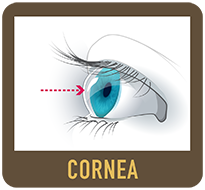Germs & Infections
Being able to see well is a vital aspect of performing daily activities for most people. Worldwide, many people rely on contact lenses (as well as glasses and eye surgery) to improve their sight. Contact lenses can provide many benefits, but they are not risk-free—especially if contact lens wearers don’t practice healthy habits and take care of their contact lenses and supplies 1. If patients seek care quickly, most complications can be easily treated by an eye doctor. However, more serious infections can cause pain and even permanent vision loss, depending on the cause and how long the patient waits to seek treatment 2, 3.
Keratitis
Contact lens wear is linked to higher risk of keratitis 2, or inflammation of the cornea (the clear dome that covers the colored part of the eye). Many contact lens wearers do not care for their contact lenses and supplies as instructed, which increases their risk of eye problems like keratitis 4-6.
 Keratitis in contact lens wearers can be caused by many factors 7. One type of keratitis, called microbial keratitis, can occur when germs invade the cornea. These germs—such as viruses, bacteria, fungi, or parasites (amebae)—are more likely to invade the eyes when contact lenses are worn for too long or are not cared for correctly 7, 8. Microbial keratitis is a serious type of eye infection in contact lens wearers, which can lead to blindness or the need for corneal transplant in the most severe cases 7.
Keratitis in contact lens wearers can be caused by many factors 7. One type of keratitis, called microbial keratitis, can occur when germs invade the cornea. These germs—such as viruses, bacteria, fungi, or parasites (amebae)—are more likely to invade the eyes when contact lenses are worn for too long or are not cared for correctly 7, 8. Microbial keratitis is a serious type of eye infection in contact lens wearers, which can lead to blindness or the need for corneal transplant in the most severe cases 7.Types of Microbial Keratitis






















.png)











No hay comentarios:
Publicar un comentario